Invisibility from any angle: already near us
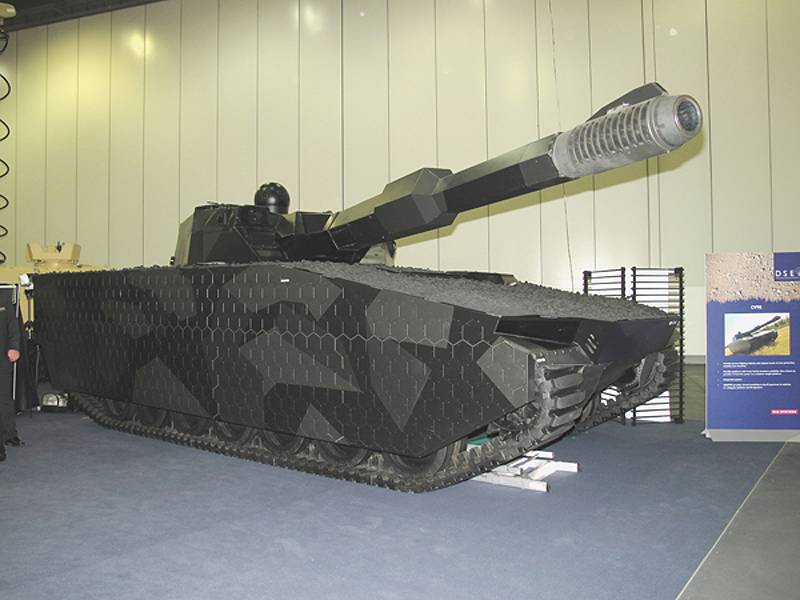
The Adaptiv camouflage system developed by BAE Systems was first shown at the DSEI 2011 exhibition on the CV-90 armored vehicle, whose gun was covered with a thermal housing to reduce the thermal signature.
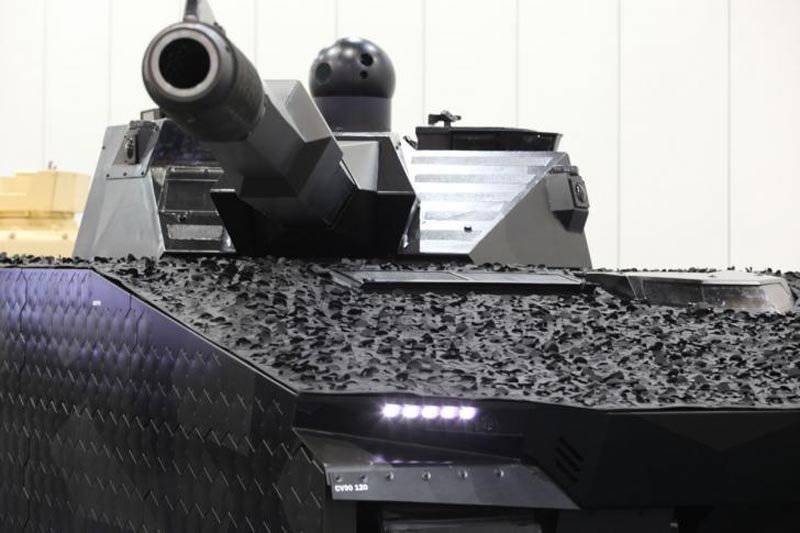
The near plan of the first version of Adaptiv, designed to reduce infrared signatures; The development program is funded by BAE Systems and the Swedish Defense Property Authority.
In the broadest sense, not to be recognized or "seen" means excluding the display of signatures of any kind, which the opponent can identify with sensors of different categories, whether with the naked eye or an advanced radio frequency or thermal imaging system. Typical signatures or signs of visibility include visual, acoustic, electromagnetic, both radar and radio frequency, and thermal. While acoustic and radiofrequency signatures are largely determined by the process flow - a traveling car or a walking soldier will inevitably create some noise - and any type of radiation from a radio station can be detected by means of electronic warfare, a camouflage system can handle visual, radar, thermal imaging signatures.
The system of BAE System Adaptiv has been tested with an unnamed customer and currently includes not only thermal imaging. but also visual possibilities
More traditional or more technological
Visual camouflage is arguably the oldest way to avoid detection since the armies in the 19th century began massively abandoning the use of color uniforms in an attempt to impress the enemy by moving on to a more advanced type of warfare. Wearing clothes painted in the background reduces the likelihood of being noticed, the same is true for camouflage coloring vehicles. Depending on the country and the current situation, camouflage changed many times - sometimes the armies tended to single-color patterns, then to multi-color ones, but the idea was always to disrupt the shape, clear contours not characteristic of nature, and mix with background colors. Radio wave absorbing materials were first used in aviationwhere the main sensory target detection system is radar; thus, the less energy that can be reflected, the less likely it is to be noticed. With the proliferation of ground surveillance radars, this has become important also for ground vehicles. As for the thermal signature, internal combustion engines, as well as the human body, are typical heat generators, therefore, an attempt to hide them from the enemy’s eyes due to specific camouflage systems is the key to maintaining their invisibility to the opponent, especially at present, when thermal imagers became commonplace.
If for soldiers the two most important spectra are thermal and visible, then for vehicles all three come into play: since they are made mostly of metal, the radar signature is of particular importance here, although modern observation radars at certain distances can detect people. Several years ago, materials were developed to reduce one type of signature, some of which could cope with even two spectra simultaneously; the solution, which can reduce signatures in all three spectra, used on both fixed and moving objects, with a minimum mass and power consumption, still has to appear on the market. In the latter case, we are talking more about active systems of varying complexity that can adapt the visual and thermal appearance of the car to the background. In this case, camouflage nets and infrared coloring are still the most common systems for hiding people and vehicles.
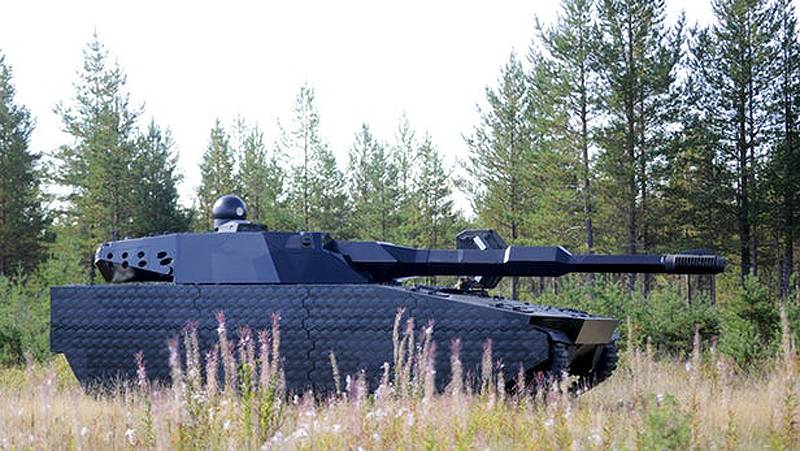
The evolution of the Adaptiv system has led to a reduction in mass and energy consumption; the whole system is at the sixth level of technological readiness
At DSEI 2011, BAE Systems Hagglunds presented a demo of the adaptive thermal camouflage system Adaptiv, which gave the name to a common multispectral camouflage solution. The CV90120-T tracked vehicle was covered with hexagonal tiles with a side of about 15 cm, the temperature of which could vary. In order to merge the machine with the background, a thermal sensor (maybe one of the sensors already on the machine), directed towards the background, measures its temperature, this data is transmitted to a computer, which sends data to each individual tile to change its temperature, to make it as close as possible to what the enemy can see behind the contour of the machine. Theoretically, it is possible to provide a merger with the background around, on all 360 °, but fortunately, cases of complete environment of the machine by opponents are quite rare. As a result, camouflaging is necessary in fact only about half of the car.
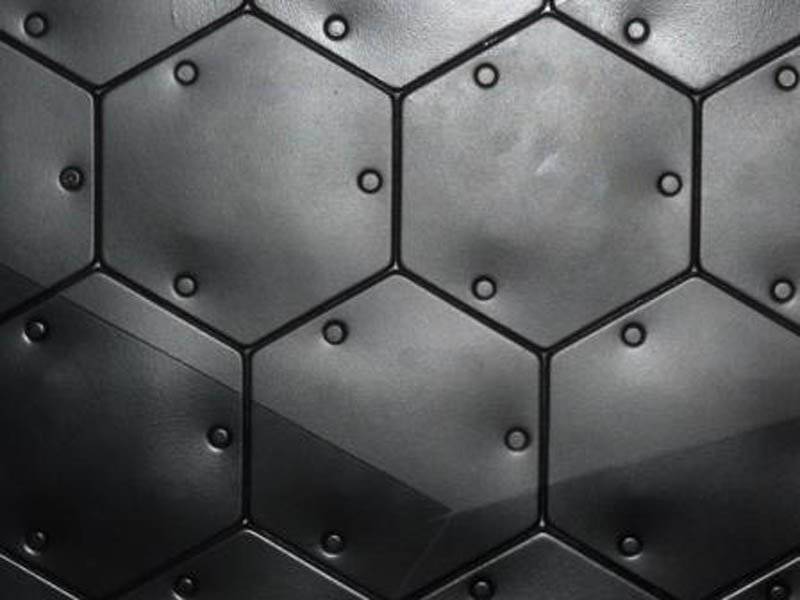
According to the company BAE Systems, the size of the Adaptiv tiles was determined taking into account the maximum observation distance of 500 meters.
The time required to change the temperature of the tiles allows you to use "camouflage in motion" up to the speed of 30 km / h. Therefore, the dimensions of the system are optimized for low visibility in the IR spectrum at a distance of about 500 meters. To break the reconnaissance and information circuit of an Adaptive opponent, it can also be used as a misleading system, since it allows you to show an IR signature of a completely different type of target. In addition to camouflage, new features can be used as a combat identifier, which can be used in the “friend or foe” system, as well as a means of communication in direct visibility, that is, for generating short QR messages. According to the company BAE Systems, the Adaptive IR system also has good radio absorbing characteristics. The thermal part of the Adaptiv system has been field tested by an unnamed customer. The company also worked a lot on design options, with particular emphasis on integration with platforms of various types. Other improvements have been implemented in the power supply system, as well as in reducing power consumption. Adaptive system can significantly reduce the capabilities of enemy radar and thermal imagers, which gives an advantage to the machine equipped with these tiles. However, unfortunately, it remains beautifully visible to the human eye, as well as to other sensors operating in the visible spectrum.
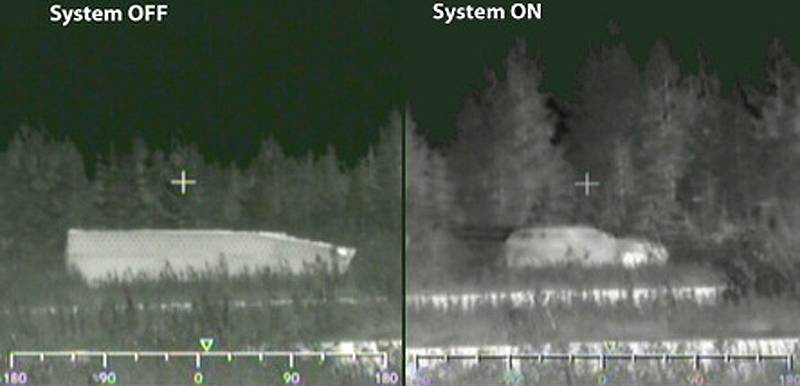
This photo allows you to see in practice the work of the Adaptiv system. Thermal signatures of an armored personnel carrier turned into signatures of a civilian vehicle
Tricky technical problem
The introduction of visual adaptive camouflage turned out to be a big problem, since “traditional” systems, for example, LED and OLED panels turned out to be incompatible with the thermal system; Another problem is camouflaging cars from different angles. The solution was found a few years ago when a breakthrough in display technology occurred, when electrochromic display panels appeared. They are a thin film that can cover thermal tiles while maintaining their properties. BAE Systems chose a “pixel” solution with a substantially less fine mesh than the heat system, the 100 order of visual pixels fit into the size of the heat tile. In this case, a system could be created that can accurately reproduce what the background consists of, making the machine completely invisible to the enemy. In principle, such a system can be obtained in a few years, but in any case it is necessary to take into account the distance from which the opponent will observe the car. Thus, BAE Systems decided to go, at least for the time being, in a more conservative way, using Adaptiv as a “virtual camouflage network”. Pre-programmed camouflage patterns in the amount of 10 to 20 base colors can be loaded into the database, which is enough to significantly reduce optical visibility from various distances. As a rule, onboard sensors can be used to capture the background texture and display the most suitable camouflage pattern on the displays; moreover, these sensors can be easily installed on the machine, if previously they were not there. The “virtual network” approach allows using the system, although not to its full potential, even in manual mode, when the operator manually enters the required type of visual and thermal camouflage through a special interface.
While sensors can be regular sensors of a machine, Adaptiv needs its own “brains” to work correctly, which, receiving information from sensors, transform it into signals of different layers of multispectral Adaptiv; the only passive element is the radar. Recently, the company began to develop an interface between the Adaptiv system and the machine, paying particular attention to its compatibility with the Generic Vehicle Architecture (general or standard vehicle architecture) in accordance with STANAG 4754.
Currently, the power consumption of the active control of the infrared signature is of the order of 20-70 W / m2, to control the visual signature, 0,5-7 W / m2 is also required. As for mass, the Adaptiv system that is attached externally weighs, as a rule, 10-12 kg / m2. Given that the average surface area of the BMP or MBT is approximately 20-25 м2, it is easy to estimate the power consumption and additional mass. BAE Systems Hagglunds did not show Adaptiv at Eurosatory 2018, possibly pending a fully developed product that can be presented at DSEI2019. Currently, BAE Systems is testing the visual part of Adaptiv with an unnamed customer. With regard to the technical readiness level, the complete system (infrared, visual, radar) is evaluated at the 6 Level (technology demonstration), while the infrared and radar components are at the 7 Level (subsystem development). The company has already conducted several field tests and plans to conduct field trials of the complete system during the 2019 year.
A large-scale demo of the Cameleon 2 presented at the Eumsatory 2018 show. The program is implemented by the French company Nexter Systems under the leadership of the Office of Defense Procurement.
Using mirrors
In France, work is also being carried out in the field of adaptive camouflage. Nexter Systems, under the leadership of the Arms Administration (DGA), is developing a system called Cameleon. Launched in 2010, this program was first introduced at Eurosatory 2014, and in 2018, the concept of Cameleon 2 was presented as a scale model. The aim of the project is also to reduce visual and infrared signatures. The Cameleon 2 system includes panels consisting of 4 pixels, each of which is able to reproduce 8 colors. Nowadays, the technology, having reached the level of a demonstration sample, is applied on rigid panels. However, the final goal is more ambitious - to develop soft material. Under laboratory conditions, a small sample of soft material was fabricated with the same characteristics as hard panels. All this is still at the level of research, but the French are determined to begin the production of camouflage nets from such material in the future. Finally, DGA, giving free rein to its fantasies, intends to begin developing combat equipment from adaptive camouflage, which may become available around 2040.
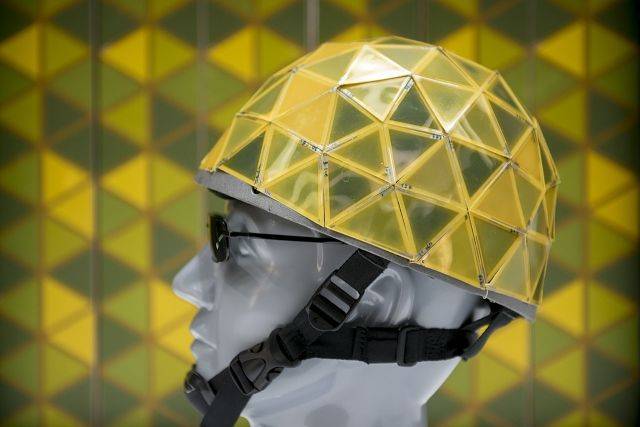
At the exhibition "Army 2018" Russian company TsNIITOCHMASH presented a prototype of an adaptive camouflage system that can be installed, for example, on helmets
Progress in visual deception
At the 2018 Army exhibition, TsNIITOCHMASH presented a prototype of an easy adaptive system for infantry, which is an array of triangular elements attached to a helmet. The company for three years has developed these elements that are able to change color when receiving an electrical signal. The stated power consumption is 3040 W / m2. Of course, the system must be integrated with a sensor capable of “seeing” the background and with a computer capable of converting the signals of the sensor into signals necessary for the color to adapt to the background color. According to the company, it will take another 2-3 of the year to develop a working prototype.
If we talk about passive camouflage, Saab Barracuda is a leader in this field, presenting several new solutions at the latest Eurosatory exhibition. The company has developed a new camouflage network for stationary applications. It is based on a completely new material that weighs less than 50 grams / m2, while this is especially important. that it remains soft to -30 °, which contributes to the extension of service life in harsh climates. Saab Barracuda has also been able to improve its multispectral properties, especially in the radar field. A two-way network usually has one side white and the other white with green spots.
Saab Barracuda added flexibility to its mobile camouflage solutions. Now each solution is designed for a specific machine in order to better cover it; in addition, now all systems have become two-way. Under normal circumstances, the whole car is covered with white panels, however, while reducing the snow cover area, the crew can quickly change color, since some panels can be easily turned over and fastened on a white surface onto specially arranged Velcro fasteners, making it possible to dilute the snow-white surface with darker patches. Created for areas with a cold climate, the solution, of course, can be implemented in camouflage systems used in other external conditions, for example, in urban areas. When creating mobile camouflage systems, Saab Barracuda works with equipment manufacturers to better fit camouflage under the respective surfaces and provide access to existing hatches.
Saab Barracuda has developed a mobile camouflage system for cars, which allows you to change part of the scheme thanks to velcro panels.
The company has always provided the training for its customers. However, at present Saab Barracuda has decided to create an academy with three types of courses that guarantee the maximum level of standardization. A three-day master course will be held in Sweden near the town of Linköping; it will include a visit to the Research and Development Department and laboratories, where cadets will be allowed to use different sensors to see with their own eyes the effects of various camouflage systems. The other two courses, also held in Sweden, will be mainly mobile groups. The first courses are intended for technical personnel who will be trained in the use of camouflage materials, various methods of camouflage machines and all activities related to the material part, including maintenance and storage. This course has a duration of two days, the same course lasts a higher level of training of instructors. The difference is not only in the program, but also in the number of students; the first can be visited as much as possible by a platoon, and the second are taught as much as possible for 8-10 people. Last but not least, Saab organized the Barracuda user group - the Barracuda User Group, whose first meeting took place in June at the Eurosatory exhibition. The purpose of this group is to discuss operational needs, the future development of signature management, and the exchange of knowledge and experience. It will be organized every year alternately at two major European defense exhibitions, Eurosatory in Paris and DSEI in London.
The close-up of the Saab Barracuda camouflage mobile system. The company also opened its Academy to provide customers with special camouflage courses.
It took Swiss company SSZ 12 years to develop Camoshield, a proprietary fabric that improves protection against the latest thermal imaging systems used in drones and air surveillance cameras armory sights and portable observation devices. The use of thermal imaging systems became more popular and affordable when devices in the well-known near infrared region of the spectrum were added to devices in the shortwave, mediumwave and longwave infrared regions of the spectrum.
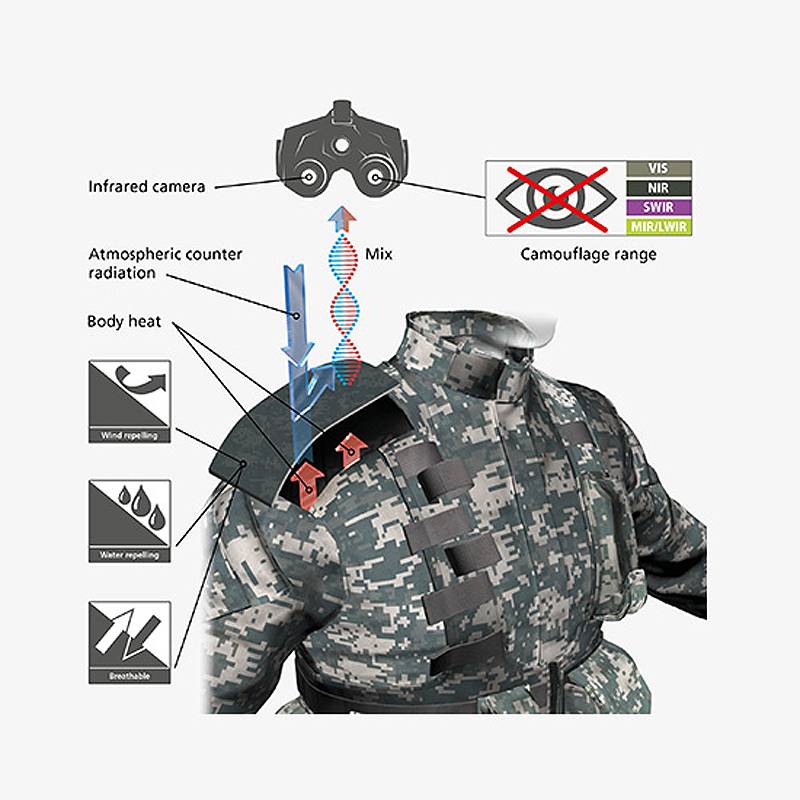
The Swiss company SSZ developed the Camoshield technology, which reduces the signature of the soldier’s military equipment in the visible and infrared spectra, and created the Swiss CamouTech division to manufacture and promote new equipment.
The technology introduced five years ago did not receive proper development, since there was no need for it yet. But the Swiss company SSZ foresaw that it will become a reality years later. Currently, the needs for this technology are clearly defined and therefore the owner of SSZ decided to create a separate company aimed at the production and promotion of clothing. Thus, at the end of 2017, Swiss CamouTech was created, choosing Schoeller Textiles Switzerland and Milliken in the USA as licensing partners for the production and promotion of their special textiles.
Little information is available about the technology itself; it is known only that it reduces the thermal signature of a person by reducing the visible infrared radiation to 10 ° C compared to a standard field uniform, thereby disrupting the shape of an object when observed through a thermal imaging system.
How Camoshield technology allows a soldier to merge with the background in the visible and infrared spectra
According to the manufacturer, Camoshield is effective throughout the entire thermal imaging spectrum, it maintains the highest level of comfort and protection from the weather, the fabric is breathable, water-repellent and specially designed for nighttime outdoor activities. It offers optimum performance at ambient temperatures from 0 ° to 37 ° C. The Camoshield kit is indistinguishable from standard combat equipment and can be supplied in several different camouflage patterns and colors to suit all climatic zones. CamouTech cooperates with Schoeller Textiles Switzerland to adapt fabric to customer needs and to add properties such as fire resistance and insecticidal impregnation from insect bites. If the customer requests to apply the technology on his own fabric, it will take a little time to develop a specialized solution. To date, the Swiss company has developed a family of products based on the Camoshield technology. Four sets of IRBD (Thermal Infrared Battle Dress) are available: fireproof and lightweight non-fireproof options, dry suit for amphibious tasks and sniper kit.
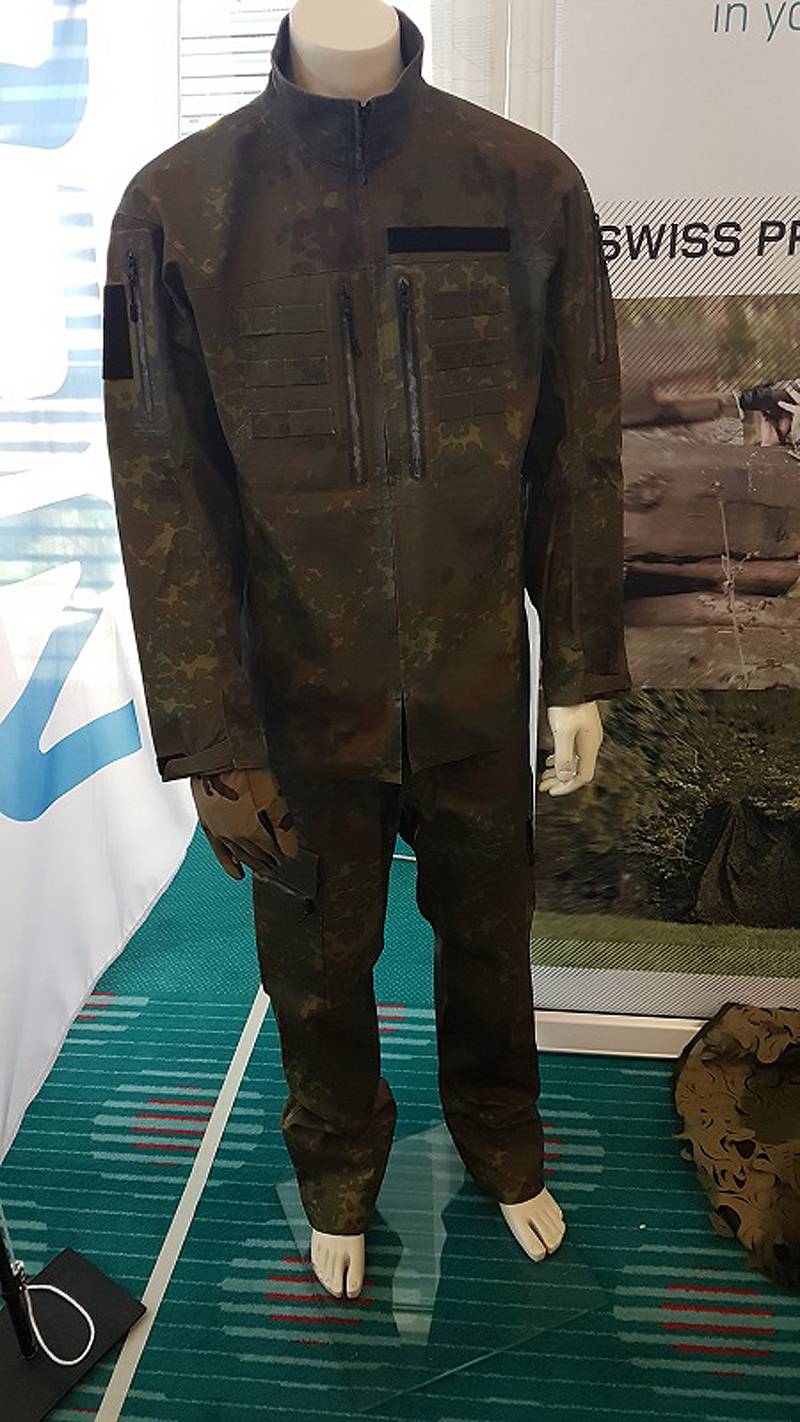
The CamouThech IRBD (Infrared Battle Dress) suit, which uses Camoshield technology, is indistinguishable from standard combat gear
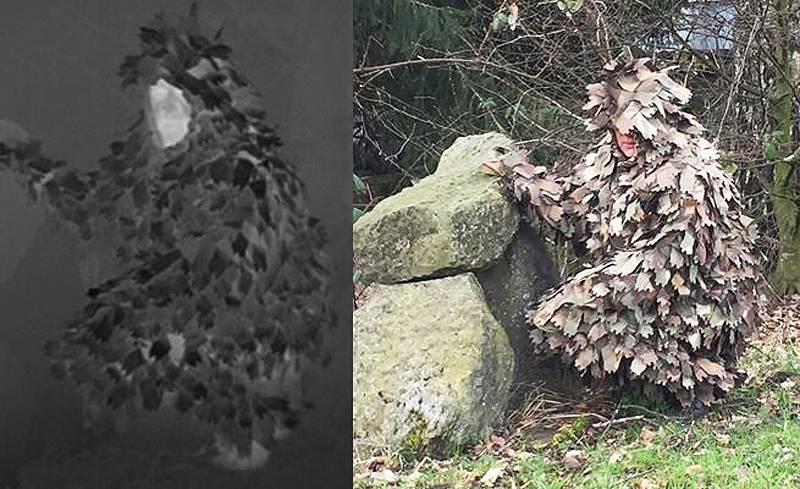
Swiss CamouTech used its Camoshield technology to design a costume for snipers.
Swiss CamouTech has received contracts for a limited number of products from customers in Europe, the USA and the Middle East, mainly special forces. After conducting an evaluation field test, the company expects large contracts in the near future.
In order to simplify the masking process, Fibrotex has developed an ultra-light Sophia Kit container with 35 camouflage meters.
Sometimes masking a machine or weapon system requires a special amount of camouflage material that is not available at this moment. To solve this problem, the Israeli company Fibrotex has developed a lightweight Kit Sophia system weighing 15 kg, consisting of a container and 35 linear meters of a double-sided grid capable of reducing signs of visibility in the visible range, near infrared and thermal infrared regions of the spectrum. This allows operators in the field to take as much of the grid as needed to hide a particular machine or system. The filled container is a cube with a side of 50 cm, the height of an empty one is reduced by 5 cm. Such a smart, inexpensive, low-tech solution allows you to simplify the service of a soldier.
On the materials of the sites:
www.nationaldefensemagazine.org
www.baesystems.com
www.hyperstealth.com
www.nexter-group.fr
www.cniitm.ru
saab.com
www.ssz-camouflage.ch
en.wikipedia.org
www.army-technology.com
www.fibrotex-tech.com
pinterest.com
www.wikipedia.org
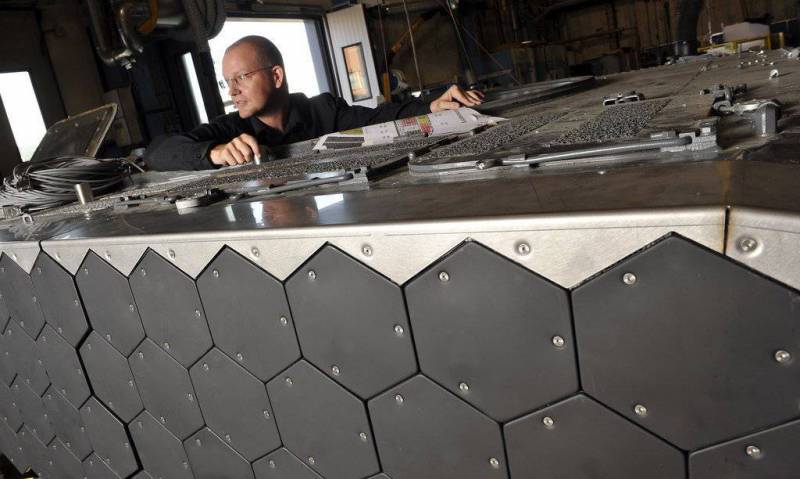
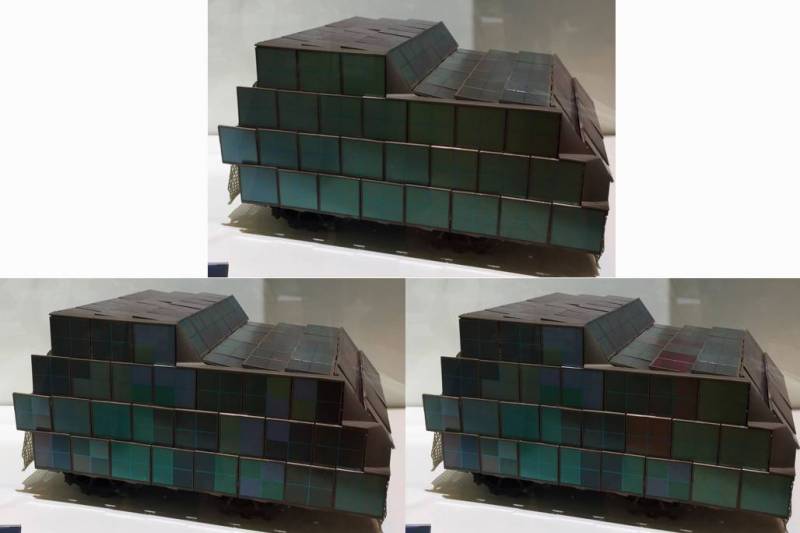
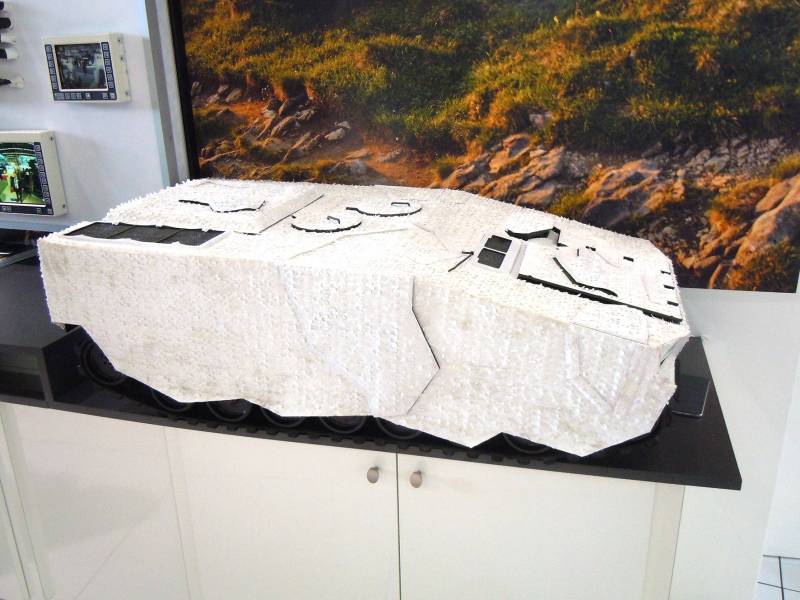
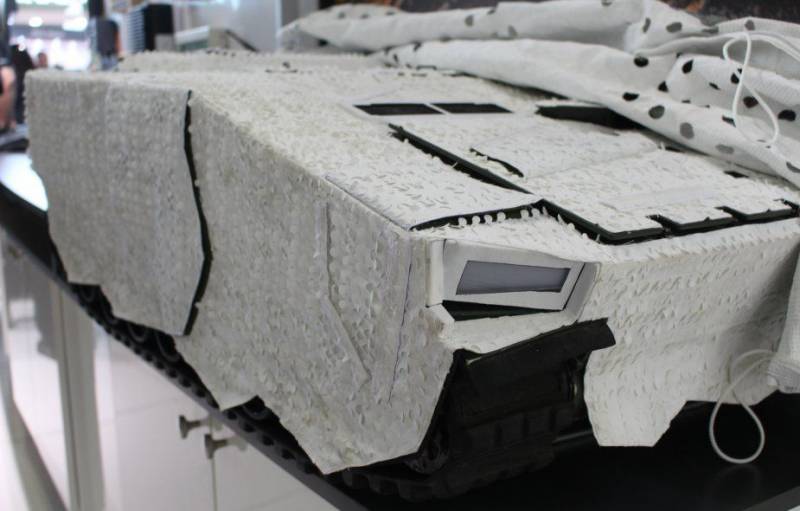
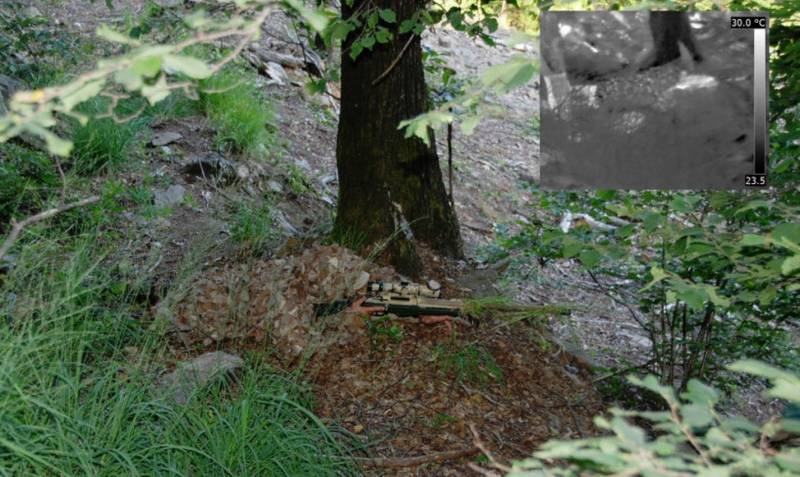
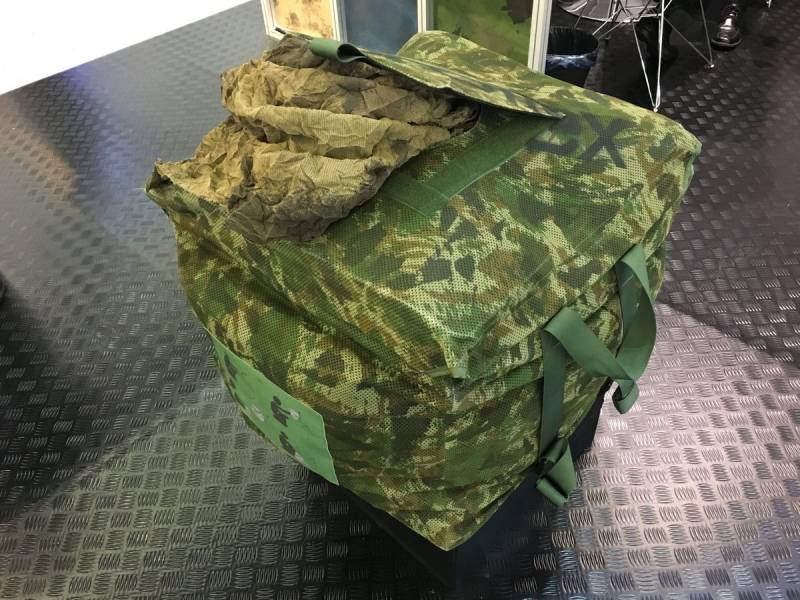
Information